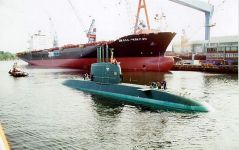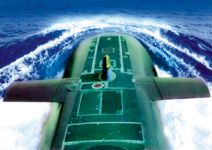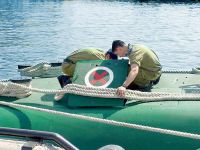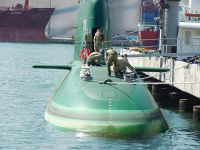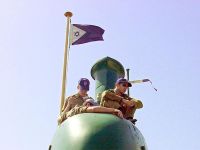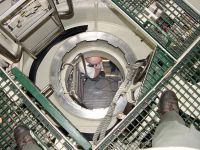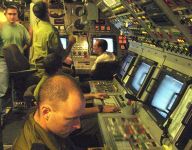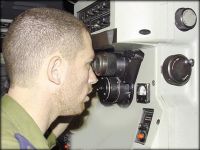Jews' Nuclear First Strike Capability
QUOTE
Three 1,925 ton Type 800 Dolphin
class submarines have been built in German shipyards for the Israel Navy.
Modern submarines with the most advanced sailing and combat systems in the
world, they combine extensive sophistication with very easy operation. The
purpose of these submarines is to enable the Israel Navy to meet all the
tasks faced in the Mediterranean Sea in the 21st century. The submarines
cost $320 million each, and are twice as big as the aging Gal-class
submarines that the Israeli navy has relied on to date.
The submarine has the capacity to carry anti-ship missiles, mines, decoys and STN Atlas wire-guided DM2A3 torpedoes. The surface-to-surface missiles may include the submarine-launched Harpoon which delivers a 227 kilogram warhead to a range of 130 kilometres at high subsonic speed. It is generally agreed that these submarines are outfitted with six 533-millimeter torpedo tubes suitable for the 21-inch torpedoes that are normally used on most submarines, including those of the United States.
Some reports suggest that the submarines have a total of ten torpedo tubes -- six 533-millimeter and four 650-millimeter. Uniquely, the Soviet navy deployed the Type 65 heavy-weight torpedo using a 650-millimeter tube. The four larger 25.5 inch diameter torpedo tubes could be used to launch a long-range nuclear-capable submarine-launched cruise missile (SLCM). According to some reports the submarines may be capable of carrying nuclear-armed Popeye Turbo Cruise Missiles, with a goal of deterring an enemy from trying to take out its nuclear weapons with a surprise attack.
Under a system of rotation, some sources claim that two of the vessels would remain at sea: one in the Red Sea and Persian Gulf, the other in the Mediterranean. A third would remain on standby.
The project initially was structured to include an industrial team consisting of HDW and Thyssen Nordseewerke, lead by Ingalls Shipbuilding. The project, under which the boats would be built in the United States by Ingalls using US FMS funds, was cancelled in 1990. The crews of the submarines started training in 1994, and participated in the building process as well as in the acceptance procedures for weapon systems. Germany donated two of these submarines to Israel, which were delivered in 1997. Israel bought a third Dolphin submarine from Germany. The project to build the Israeli Navy's third submarine, named "Tekumah ," was launched in Germany on 09 July 1998 with the participation of Defense Ministry Director General Ilan Biran and other naval officers. Tekumah [T'kuma] is the Hebrew word for "revival." The third submarine arrived in Israel during mid-1999.
A major role for hunter, killer and patrol submarines is the destruction of enemy submarines and shipping. In order to achieve this, the submarine must load, store and launch a range of stores. The submarine must also detect its target while attempting to remain covert. The Israel Navy has three Gal submarines. They were built in the 1970s at the Vickers shipyard in Britain, based on German blueprints. The Gal submarines are an important part of the main combat force of the Israel Navy.
The German Type 209 diesel electric submarine is the most popular export-sales submarine in the world, and sales continue as smaller nations modernize their aging fleets. Greece was the first country to order this type of submarine from Howaldtswerke-Deutsche Werft AG (HDW) of Kiel, Germany, and the first batch of these submarines entered service in 1971. The 1,200-ton Type 209 submarine is a hunter killer submarine that India purchased from HDW, Germany. The initial contract was for 2 submarines to be sold and for 4 more to be constructed at the Mazagaon docks in Mumbai. The deal however went sour when it was hit by a bribery scandal, after the first four ships were delivered to the Indian Navy.
Advances in electric drive and power conditioning were introduced into the German Type 212. This German submarine has low and balanced signatures including acoustic signatures, longer submerged mission capability and a modern combat system with sophisticated sensors and state of the art torpedoes. The technologies inherent in this design include a fuel cell air independent propulsion (AIP) system with a back up single diesel generator, highly modular arrangements of critical areas and the frame carrying the diesel generator and auxiliary equipment such as the hydraulic pumps, compressors, etc.- is enclosed in a sound absorbent capsule and isolated from the pressure hull. The AIP system utilized is more commonly called 'MESMA'. Translated it means Autonomous Submarine Energy Module and was developed for submarines.
The 1,720-ton Dolphin class is evidently somewhat larger than the 1,500-ton Type 212 submarines, and incorporates a conventional diesel-electric propulsion system rather than the AIP system.
The detection that the submarines were equipped with two types of torpedo tubes (533mm and 650mm respectively) fueled speculation that the submarine might have a possible nuclear role, given that 533mm torpedo tubes would have been sufficient for the weaponry that was to be installed on board.
When questioned about this in parliament, the German government confirmed the presence of the 650mm tubes in the Dolphin submarines but could not provide an explanation, other than that the tubes were to be fitted with liners upon delivery to reduce the tubes' diameters to 533mm. Because 50% of design rights are reported to belong to Israel, and, as a result it had no 'design authority', the German government claimed that it could not have any knowledge of the larger tubes' purpose.
An article published by the Los Angeles Times in mid-October 2003, indicated that Israel had successfully modified American-supplied Harpoon cruise missiles for use with nuclear warheads on its submarines. The process would have involved reducing the size of the warheads to fit inside the missiles as well as altering the guidance systems so as to be able to hit land-based targets, but would enable Israel to deliver nuclear weapons from the sea virtually unimpeded. The claim was however disputed by Israeli and others who questioned the ability of the Harpoon missile to carry a nuclear payload.
As of early November 2003, it was reported by the German newspaper Berliner Zeitung, that Germany's leading shipyard company HDW was involved in negotiations with Israel to construct two additional Dolphin submarines. HDW confirmed these conversations, which were said to be of a purely technical nature and claimed the German government had approved them. It was also reported that Israeli engineers had modified the missile launching pads of earlier Dolphin submarines at the Kiel's HDW dockyard, possibly to accommodate nuclear warheads.
The German Focus magazine
reported on November 24, 2003, that the German government had halted the
delivery of the two submarines to Israel. It was later clarified that while
Israel did have an interest in additional submarines, given the financial
burden associated with such a deal for Israel, Washington or Germany, only
technical negotiations were being conducted with HDW, and that as a result,
neither a formal nor preliminary request for any export license had been
issued. The German Green party, however, who had originally opposed the
delivery of the first three dolphin submarines, demanded that, in the
future, additional submarines could only be delivered to Israel on the basis
of a binding assurance that they would not be used as nuclear weapons
platforms.
|
Specifications |
|
|---|---|
|
Displacement |
1640 surfaced |
|
Propulsion |
Diesel-electric 3 diesels, 1 shaft, 4,243 shp |
|
Length |
57.3 m (188ft) |
|
Beam |
6.8 m (22.6ft) |
|
Draft |
6.2 m (20.5ft) |
|
Height |
12.7 m |
|
Speed |
20 knots submerged
|
|
Sonar |
??? |
|
Operating Depth |
Deeper than 200m (600 feet) |
|
Armament |
6 x 21 inch (533mm) torpedo tubes (14 torpedoes & Harpoon SSM) German-built 4 x 25.6 inch (650mm) bow torpedo tubes 6 reloads |
|
Crew |
35 |
|
Range |
4500 miles at 8 knots |
|
Banks
|
35 |
|
Provision |
More than one month |
|
Ship List |
|||
|---|---|---|---|
|
Number |
Name |
Year |
Homeport |
|
?? |
Dolphin |
5/1998 |
-- |
|
?? |
Leviathan |
1999 |
-- |
|
?? |
Tekumah |
1999 |
-- |
|
?? |
-- |
? 2006 |
-- |
|
-- |
-- |
? 2007 |
-- |
Popeye Turbo Cruise Missiles
QUOTE
In May 2000, Israel is reported to have secretly carried out its first test
launches from two German-built
Dolphin-class
submarines of cruise missiles capable of carrying nuclear warheads. The
missiles launched from vessels off Sri Lanka in the Indian Ocean are said to
have hit a target at a range of about 1,500 kilometers [about 930 statute
miles]. Israel is reported to possess a 200kg nuclear warhead, containing
6kg of plutonium, that could be mounted on cruise missiles.
Israel has reportedly developed an air-launched cruise missile that could be operational by 2002, called the Popeye Turbo. The Popeye Turbo, with a range that is variously reported at between 200 km and 350 km, would appear to represent a turbo-jet powered cruise missile that may incorporate avionics and other components developed for the Popeye family of missiles. The AGM-142 HAVE NAP is a variant of the Israeli Air Force "Popeye" missile, which uses a solid propellant rocket motor. The Popeye II, also known as the Have Lite, is a smaller missile with more advanced technology. Designed for deployment on fighter aircraft, Popeye II has a range of 150 kilometers.
The Popeye Turbo missile is probably
similar to if not identical with the Israeli submarine-launched cruise
missile carried on the Dolphin-class submarines. The baseline Popeye
missile with a range of 45 miles has a diameter of 21 inches, and is nearly
16 feet long. For comparison, the American MK-48 heavy torpedo is 21 inches
in diameter, and 19 feet long, while the BGM-109 Tomahawk SLCM is 20.4
inches in diameter and 20.5 feet long [including the booster motor], and the
Russian SS-N-21 SLCM is similar in configuration and dimensions to the
American Tomahawk.
UNQUOTE
These things could spoil your day.
Popeye Plus
QUOTE
The AGM-142 Have Nap is a development of the
Israeli
Popeye missile, it is a joint project between
Lockheed Martin and the
Israeli
company
Rafael Advanced Defense Systems Ltd. The weapon is designed for
precision attack against large targets from
stand off ranges. The missile is powered by a single stage
solid rocket. An
inertial guidance system pilots the missile towards the target; for
terminal homing the pilot can control the missile directly via an INS and
data link,
aiming via either a
television or imaging infrared seeker depending on the missile model. It
is not necessary for the launching aircraft to direct the missile - control
can be passed to another platform whilst the firing aircraft escapes the
area. There are two choices of warhead, a 340 kg (750 lb)
blast/fragmentation or 360 kg (800 lb) penetrator.
UNQUOTE
Nasty things. That is why Jews like them.
